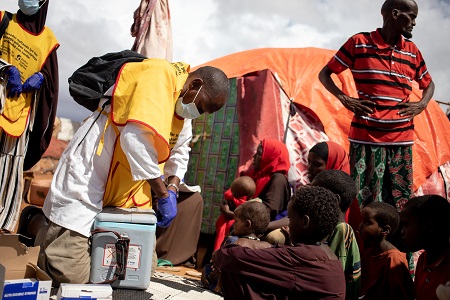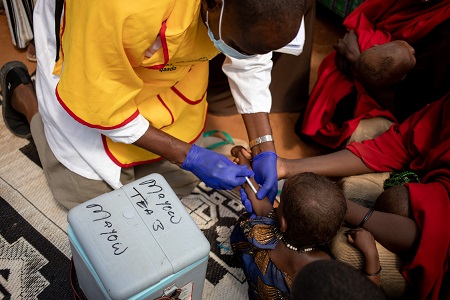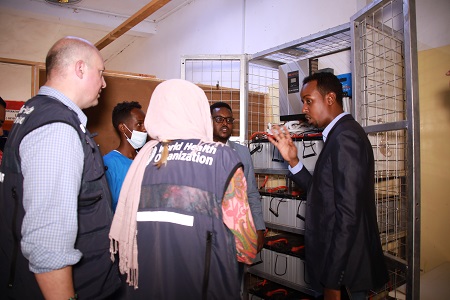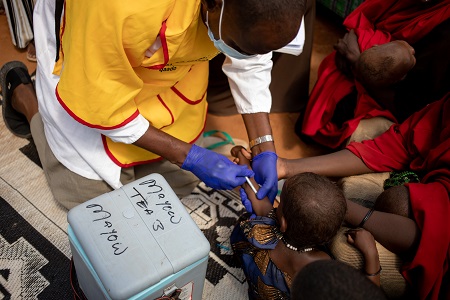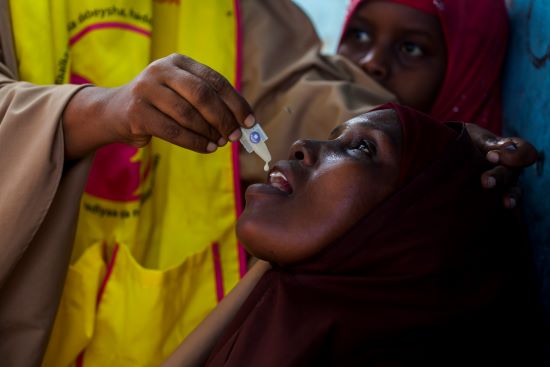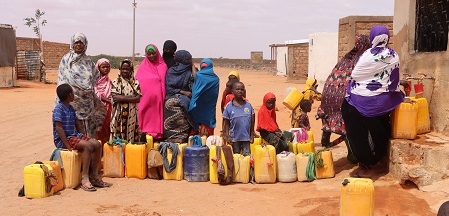 Children and adults queuing to collect water from the newly rehabilitated Salama borehole, North Galkayo, Puntland, 2 July 2022. Credit: WHO Somalia6 July 2022 – Water is a key prerequisite to safe hygiene and sanitation practices and — by that measure — good health and dignity. However, a large proportion of the Somali population has limited access to this valuable resource. Estimates from a survey conducted by the government and UN in 2014 state that 24% of Somalis live in rural areas, 23% follow nomadic lifestyles, and 15% (around 2.6 million) live in camps for the internally displaced. This means most communities living across Somalia’s expansive, dry landscape rely on rivers, wells, water trucks and boreholes to access water of compromised quality. The ongoing drought, which is the worst the Horn of Africa has witnessed in four decades, has placed water even further out of reach.
Children and adults queuing to collect water from the newly rehabilitated Salama borehole, North Galkayo, Puntland, 2 July 2022. Credit: WHO Somalia6 July 2022 – Water is a key prerequisite to safe hygiene and sanitation practices and — by that measure — good health and dignity. However, a large proportion of the Somali population has limited access to this valuable resource. Estimates from a survey conducted by the government and UN in 2014 state that 24% of Somalis live in rural areas, 23% follow nomadic lifestyles, and 15% (around 2.6 million) live in camps for the internally displaced. This means most communities living across Somalia’s expansive, dry landscape rely on rivers, wells, water trucks and boreholes to access water of compromised quality. The ongoing drought, which is the worst the Horn of Africa has witnessed in four decades, has placed water even further out of reach.
Visit to camps for internally displaced persons
On a bright, sunny morning on 10 May 2022, a high-level mission from Somalia’s Federal Ministry of Health and Human Services, the Puntland state Ministry of Health and the World Health Organization (WHO) visited North Galkayo to assess the health situation brought about by the drought.
Led by HE Dr Fawziya Abikar Nur, the Federal Minister of Health and Human Services, and HE Abdi Nasir Yusuf Haji, the Vice Minister of Health for Puntland state, the team included Dr Ahmed Al-Mandhari, the Regional Director for the WHO Eastern Mediterranean Regional Office and Dr Mamunur Rahman Malik, WHO Representative to Somalia.
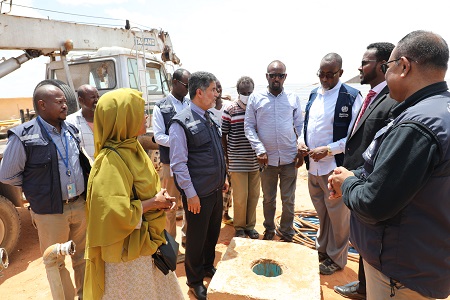 Dr Ahmed Al-Mandhari, WHO Regional Director for the Eastern Mediterranean, and Dr Mamunur Malik, WHO Representative to Somalia, visiting the Salama borehole when it was not functioning, North Galkayo, 10 May 2022. Credit: WHO Somalia/Fouzia Bano
Dr Ahmed Al-Mandhari, WHO Regional Director for the Eastern Mediterranean, and Dr Mamunur Malik, WHO Representative to Somalia, visiting the Salama borehole when it was not functioning, North Galkayo, 10 May 2022. Credit: WHO Somalia/Fouzia Bano
During a visit to two camps for internally displaced persons (IDPs)– the Salama and Halaboqad camps – the team observed that the communities living there had no access to water. At the Salama camp, a borehole that used to provide water to around 2000 households and 12 000 people residing in six camps was broken. Similarly, the borehole at the Halaboqad camp, which usually serves around 7716 people, was not functioning as its water pump required solar batteries or a generator and pipes to carry water.
When delivering promises turns into happiness
The local communities, while meeting Dr Al-Mandhari and Dr Malik, raised their attention of the acute water shortage they were facing in the camp. After seeing the plight of the local communities and believing that access to safe water is a human right for everyone, everywhere, Dr Ahmed Al-Mandhari and Dr Malik committed to support the rehabilitation of two boreholes in both camps, which can permanently solve the acute water crisis faced by marginalized community members. Within the same week, WHO arranged for engineers to assess both boreholes.
In a month’s time, by 16 June 2022, both boreholes were rehabilitated, and a total of around 19 716 people living in both locations now have access to safe water, which has already started to change the life of these communities. This intervention will significantly reduce the prevalence of diseases among communities being served in addition to meeting their daily needs for water. The communities are happily using safe water from this borehole for all their household needs and thanking WHO for delivering its promises to safeguard lives of their children and elderly people.
WHO urges partners to redouble efforts
During his mission, Dr Ahmed Al-Mandhari urged partners to redouble efforts to support Somali communities during this trying time.
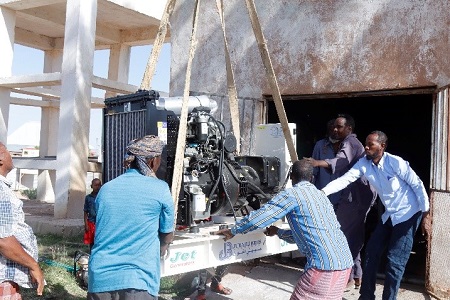 Rehabilitation efforts at the Halaboqad borehole after the high-level visit, North Galkayo, June 2022. Credit: WHO Somalia “It is really very heart-breaking to see the impact of drought. Let us come together to save lives,” said Dr Ahmed Al-Mandhari, the WHO Regional Director for Eastern Mediterranean Regional Office. “We see children, mothers and families suffering due to the shortage of water and food. I have seen young babies emaciated and admitted in hospitals due to malnutrition and related complications, such as pneumonia. These are all not just numbers, but human lives, and future generations of Somalia suffering from drought and the related impact of it – physical, mental, emotional or psychological. Let us all work towards fulfilling the spirit and values of the WHO Eastern Mediterranean Region vision 2023: health for all by all – calling for solidarity and action.”
Rehabilitation efforts at the Halaboqad borehole after the high-level visit, North Galkayo, June 2022. Credit: WHO Somalia “It is really very heart-breaking to see the impact of drought. Let us come together to save lives,” said Dr Ahmed Al-Mandhari, the WHO Regional Director for Eastern Mediterranean Regional Office. “We see children, mothers and families suffering due to the shortage of water and food. I have seen young babies emaciated and admitted in hospitals due to malnutrition and related complications, such as pneumonia. These are all not just numbers, but human lives, and future generations of Somalia suffering from drought and the related impact of it – physical, mental, emotional or psychological. Let us all work towards fulfilling the spirit and values of the WHO Eastern Mediterranean Region vision 2023: health for all by all – calling for solidarity and action.”
“Currently, 3.5 million people in Somalia lack adequate access to water,” said Dr Mamunur Malik. “This increases communities’ chances of contracting diseases like cholera and diarrhoea. We are hereby appealing to both the health and the water, sanitation and hygiene (WASH) clusters in Somalia to work hand in hand to protect Somalis from preventable diseases and give them access to safe water and sanitation services, which are their human right.”
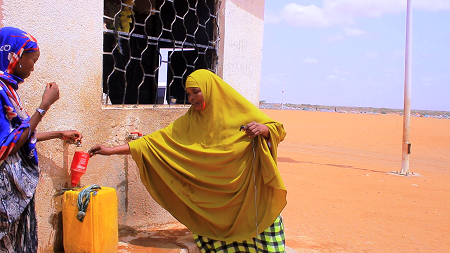 A lady draws water for her household from the Salama borehole, North Galkayo, July 2022, Credit: WHO SomaliaDr Malik added that WHO estimates that for every US $1 that donors and partners spend today to prevent and prepare for epidemics in Somalia, it will save US$ 35 in response to epidemics. Early action saves more lives, he emphasized.
A lady draws water for her household from the Salama borehole, North Galkayo, July 2022, Credit: WHO SomaliaDr Malik added that WHO estimates that for every US $1 that donors and partners spend today to prevent and prepare for epidemics in Somalia, it will save US$ 35 in response to epidemics. Early action saves more lives, he emphasized.





